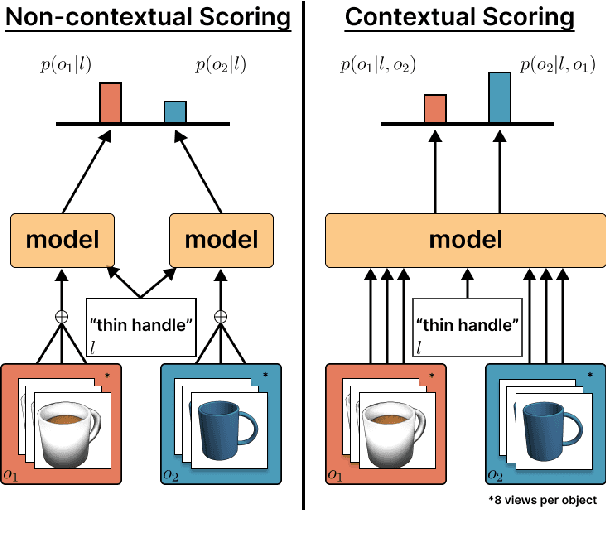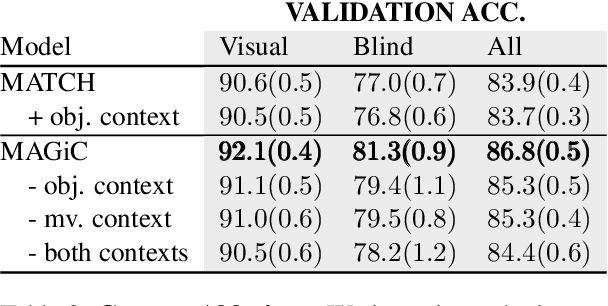Chancharik Mitra
Sparse Attention Vectors: Generative Multimodal Model Features Are Discriminative Vision-Language Classifiers
Nov 28, 2024



Abstract:Generative Large Multimodal Models (LMMs) like LLaVA and Qwen-VL excel at a wide variety of vision-language (VL) tasks such as image captioning or visual question answering. Despite strong performance, LMMs are not directly suited for foundational discriminative vision-language tasks (i.e., tasks requiring discrete label predictions) such as image classification and multiple-choice VQA. One key challenge in utilizing LMMs for discriminative tasks is the extraction of useful features from generative models. To overcome this issue, we propose an approach for finding features in the model's latent space to more effectively leverage LMMs for discriminative tasks. Toward this end, we present Sparse Attention Vectors (SAVs) -- a finetuning-free method that leverages sparse attention head activations (fewer than 1\% of the heads) in LMMs as strong features for VL tasks. With only few-shot examples, SAVs demonstrate state-of-the-art performance compared to a variety of few-shot and finetuned baselines on a collection of discriminative tasks. Our experiments also imply that SAVs can scale in performance with additional examples and generalize to similar tasks, establishing SAVs as both effective and robust multimodal feature representations.
Multimodal Task Vectors Enable Many-Shot Multimodal In-Context Learning
Jun 21, 2024Abstract:The recent success of interleaved Large Multimodal Models (LMMs) in few-shot learning suggests that in-context learning (ICL) with many examples can be promising for learning new tasks. However, this many-shot multimodal ICL setting has one crucial problem: it is fundamentally limited by the model's context length set at pretraining. The problem is especially prominent in the multimodal domain, which processes both text and images, requiring additional tokens. This motivates the need for a multimodal method to compress many shots into fewer tokens without finetuning. In this work, we enable LMMs to perform multimodal, many-shot in-context learning by leveraging Multimodal Task Vectors (MTV)--compact implicit representations of in-context examples compressed in the model's attention heads. Specifically, we first demonstrate the existence of such MTV in LMMs and then leverage these extracted MTV to enable many-shot in-context learning for various vision-and-language tasks. Our experiments suggest that MTV can scale in performance with the number of compressed shots and generalize to similar out-of-domain tasks without additional context length for inference.
Compositional Chain-of-Thought Prompting for Large Multimodal Models
Nov 27, 2023Abstract:The combination of strong visual backbones and Large Language Model (LLM) reasoning has led to Large Multimodal Models (LMMs) becoming the current standard for a wide range of vision and language (VL) tasks. However, recent research has shown that even the most advanced LMMs still struggle to capture aspects of compositional visual reasoning, such as attributes and relationships between objects. One solution is to utilize scene graphs (SGs)--a formalization of objects and their relations and attributes that has been extensively used as a bridge between the visual and textual domains. Yet, scene graph data requires scene graph annotations, which are expensive to collect and thus not easily scalable. Moreover, finetuning an LMM based on SG data can lead to catastrophic forgetting of the pretraining objective. To overcome this, inspired by chain-of-thought methods, we propose Compositional Chain-of-Thought (CCoT), a novel zero-shot Chain-of-Thought prompting method that utilizes SG representations in order to extract compositional knowledge from an LMM. Specifically, we first generate an SG using the LMM, and then use that SG in the prompt to produce a response. Through extensive experiments, we find that the proposed CCoT approach not only improves LMM performance on several vision and language VL compositional benchmarks but also improves the performance of several popular LMMs on general multimodal benchmarks, without the need for fine-tuning or annotated ground-truth SGs.
Comparative Multi-View Language Grounding
Nov 14, 2023



Abstract:In this work, we consider the task of resolving object referents when given a comparative language description. We present a Multi-view Approach to Grounding in Context (MAGiC) that leverages transformers to pragmatically reason over both objects given multiple image views and a language description. In contrast to past efforts that attempt to connect vision and language for this task without fully considering the resulting referential context, MAGiC makes use of the comparative information by jointly reasoning over multiple views of both object referent candidates and the referring language expression. We present an analysis demonstrating that comparative reasoning contributes to SOTA performance on the SNARE object reference task.
 Add to Chrome
Add to Chrome Add to Firefox
Add to Firefox Add to Edge
Add to Edge